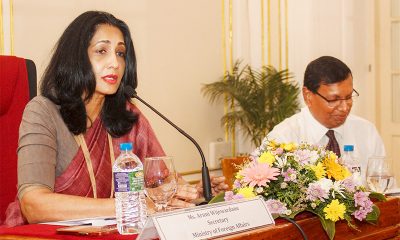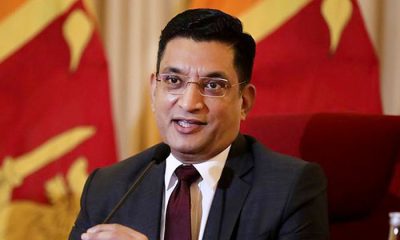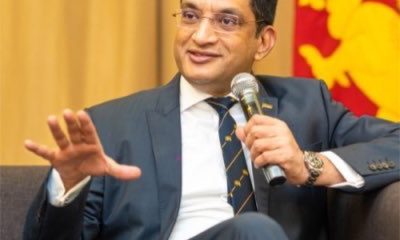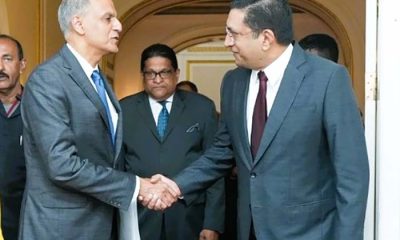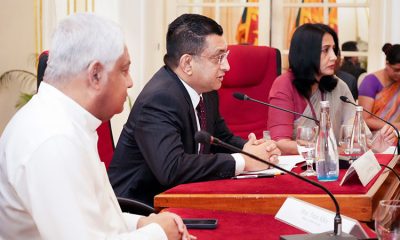Midweek Review
New diplomatic postings, current priorities and challenges
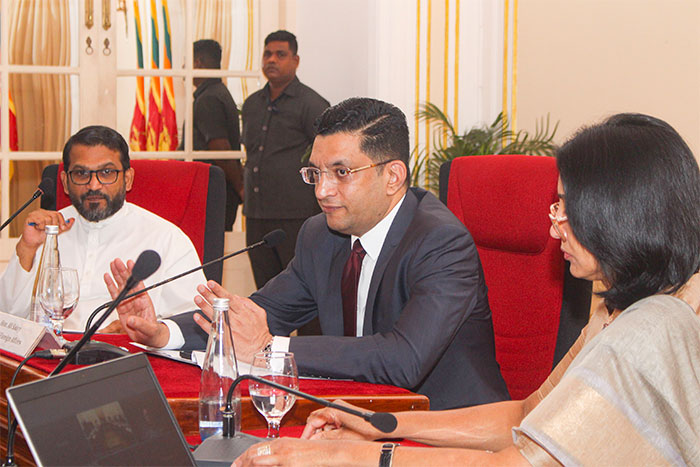
Defeated UNP candidate among new appointees
Sri Lanka’s growing dependence on bilateral assistance in addition to the anticipated USD 2.9bn credit facility from the International Monetary Fund (IMF) is frightening. A statement issued by the Indian High Commission, in Colombo, on Dec 23, 2022, after the handing over of 125 Sport Utility Vehicles to Public Security Minister, Tiran Alles, emphasized the seriousness of the economic crisis. The supply of the first batch of altogether 500 vehicles, to be procured under a USD 100 mn credit line, made available, some time ago, should be examined against the backdrop of the following: (1) Concessional credit lines worth USD 3.2 bn provided by Delhi in diverse sectors including railways, infrastructure, defence, renewable energy, supply of petroleum products, fertiliser, etc. (2) In addition, Sri Lanka received another concessional credit facility amounting to USD 1 bn, through the State Bank of India, for the procurement of essential items.
By Shamindra Ferdinando
The Foreign Ministry, in a press release dated Dec. 27, 2022, announced the appointment of 14 heads of diplomatic missions, and two heads of posts. The new appointees included 13 members of the Sri Lanka Foreign Service (SLFS).
The statement issued by the Public Diplomacy Division appreciated President Ranil Wickremesinghe for giving the lion’s share of appointments to the SLFS. There hadn’t been a previous instance of the Foreign Ministry issuing such a commendation to any of Wickremesinghe’s predecessors.
The FM says it has conducted an orientation programme (Dec. 16-23, 2022) for the group with Foreign Affairs Minister Ali Sabry, PC, discussing his Ministry’s current priorities and foreign policy challenges. Sabry, a close confidant of the ousted President, received the Foreign Affairs portfolio at the expense of academic Prof. G. L. Peiris.
Foreign Secretary Aruni Wijewardane has discussed the leadership role of heads of missions, whereas the orientation programme included discussions on economic, political, security, cultural and consular matters and field visits to the Northern Province, as well as to other government institutions.
Political appointees in the group are Admiral Jayanath Colombage (Indonesia), Udaya Indrarathna (UAE) and Sandith Samarasinghe (Consul General in Melbourne). Sandith Samarasinghe represented the UNP, in Parliament, (2015-2020/Kegalle district). Samarasinghe was one of the few MPs who remained loyal to Wickremesinghe, in the wake of the formation of the Samagi Jana Balavegaya (SJB), in early 2020. Samarasinghe, like all other UNPers, failed to retain his Kegalle district seat, at the last general election, held later that year. Even Wickremesinghe only managed to enter Parliament, through the sole seat the party secured, via its National seat.
One-time Navy Commander, Colombage, who served as the Additional Secretary (Foreign Affairs) to the then President Gotabaya Rajapaksa, since Dec., 2019, received the appointment as Foreign Secretary till August 2020. Wimal Weerawansa and sevearl others accused Colombage of pursuing an agenda inimical to Sri Lanka. Colombage earned the wrath of some over his affiliation with the Pathfinder Foundation, founded by our High Commissioner in New Delhi, Milinda Moragoda. It focuses on bilateral relations with China and India. Colombage has strongly denied any wrongdoing.
The incumbent FS Wijewardane was brought in as FS in May, 2020 amidst unprecedented political turmoil, triggered by violent protests, directed at the then President. Wijewardane succeeded Colombage, who has now received a diplomatic posting, to Indonesia, after he lost an opportunity to secure the ambassadorship in Japan.
Had President Gotabaya Rajapaksa realised the gravity of the situation, he wouldn’t have allowed his media team to declare those who launched high profile protest campaign, most probably instigated by hidden hands on March 31, 2022, outside his private residence, at Pangiriwatte, Mirihana, as extremists seeking to stage an ‘Arab Spring’ type revolution without an inclination to stand up to them. The government’s overall lackadaisical response emboldened protests, while the core reason for the crisis, the lack of foreign currency to finance basic needs, remained unaddressed, as it was beyond its means.
Governor of the Central Bank Dr. Nandalal Weerasinghe, in the second week of April, 2022, declared what he called a pre-emptive negotiated default as Sri Lanka made unilateral announcement that it wouldn’t repay foreign loans. Dr. Weerasinghe earned the appreciation of the public for making the declaration of bankruptcy, regardless of the consequences. Sabry, who served as the Finance Minister at that time had the courage to accept responsibility for Dr. Weerasinghe’s statement.
However, the declaration of bankruptcy also accelerated anti-government protests. The US threw its weight behind the campaign. US Ambassador to Sri Lanka Julie Chung interfered with the government strategy so much so that she issued a statement on May 09 as well organised mobs with specific intelligence, went on the rampage across the country, mainly against government politicians and their properties, calling on law enforcers not to crack down on peaceful protesters. Lawmaker Wimal Weerawansa, both in and out of Parliament, alleged that President Gotabaya Rajapaksa hesitated to suppress the protest campaign as he didn’t want to antagonize the US.
The current crisis cannot be examined without taking into consideration the overall failure of successive governments, particularly President Mahinda Rajapaksa’s war-winning administration (2005-2014) and the Yahapalana government (2015-2019) and the disastrous President Gotabaya Rajapaksa rule (2019-July 2022). This is not to say that the Chandrika Kumaratunga administration was any better as, under that dispensation, the country, for the first time, even recorded a negative growth.
UNP leader President Ranil Wickremesinghe in July last year received a parliamentary mandate to lead the economic recovery. As President, and the Minister in charge of the Finance portfolio, Wickremesinghe should address political, economic and social issues with an open mind. The continuing crisis is extraordinary, the executive needs the unstinted support of the legislature to ensure successful economic recovery in a reasonable time.
But the Executive President must also ensure that ‘robber barons’ are not allowed to exploit the situation, in the name of capitalism, which he wholeheartedly backs, and he must ensure greater discipline and adherence to fair play by the private sector while it continues to be the engine of growth. Particularly, he must ensure that exporters who have surreptitiously stashed export proceeds abroad bring them back to the country as such practices have exacerbated the foreign exchange crisis here, He also must stamp out the underground banking system that has been stealing billions in foreign exchange, earned by our expatriate workers, through punitive punishment and active crackdown by the law enforcers and the Central Bank. Then there are the professional tax dodgers who with the help of unscrupulous firms of Chartered accountants, have been robbing the country, with the help of the lax legal system, while the honest tax payers are often harassed to the limit.
Unfortunately, the executive and legislature seemed to be pulling in different directions, as underscored by the failure on the part of President Wickremesinghe and his parliamentary sponsor, the Sri Lanka Podujana Peramuna (SLPP) to reach a consensus on Cabinet appointments.
As many as 12 vacancies remained in the 30-member Cabinet-of-Ministers. Wickremesinghe named his first set of ministers, on July 22, 2022, soon after the SLPP overwhelmingly elected the UNPer as the first President appointed by Parliament.
Irreversible damage
The Foreign Ministry’s success largely depends on the overall political strategy adopted by the government. There is no point in denying the fact that those who caused irreversible and catastrophic damages never accepted responsibility for their actions. The Yahapalana government decision to co-sponsor an accountability resolution against Sri Lanka, in Oct., 2015, is a case in point.
The then Prime Minister Wickremesinghe and President Maithripala Sirisena never absolved themselves of the responsibility for betraying the war-winning armed forces. The Yahapalana government co-sponsored the US-led resolution, in spite of then Sri Lanka’s Permanent Representative, in Geneva, Ravinatha Aryasinha, rightfully, and spontaneously, taking a strong stand against it. The career diplomat was, however, ordered by Colombo to toe the then government’s line, soon after, which came as strange news to many, like how the UNP government signed a disastrous one sided ceasefire agreement with the LTTE, in 2001, unknown to many in that regime, including then President Chandrika Kumaratunga, who was the country’s Defence Minister.
Sri Lanka is firmly on the Geneva agenda, though Gotabaya Rajapaksa’s government tried to deceive the public by high profile pronouncement that it withdrew from the controversial resolution. The Rajapaksa administration absolutely did nothing to set the record straight, in Geneva. Regardless of promises and accusations, the then Joint Opposition (breakaway faction of the UPFA, led by Mahinda Rajapaksa) directed at the Yahapalana leadership over the handling of Geneva issue, the Rajapaksa administration treacherously refrained from defending the military. The government ensured that the powerful ‘ammunition’, provided by Lord Naseby, way back, in Oct. 2017, and other available ‘evidence’, was never properly utilized. May be the Rajapaksas did not have the required backing from our career diplomatic service as it had been much compromised, especially since 1977.
Rudderless diplomatically, the Rajapaksa administration allowed the Western agenda to continue. In other words, Sri Lanka fully cooperated with those who mercilessly exploited unsubstantiated war crimes allegations to advance their cause. The declaration of Sri Lanka’s bankruptcy status, in April 2022, should be examined against the Western agenda that continuously harassed the country over eradication of terrorism. Some couldn’t obviously stomach Sri Lanka’s triumph over terrorism, hence the persistent campaigning at the UNHRC.
Western powers will unashamedly use trumped up war crimes and unprecedented economic fallout to pressure Sri Lanka to give in. Foreign Minister Sabry never denied Rear Admiral Sarath Weerasekera’s accusation that the President’s Counsel pushed for 21st Amendment on the basis that the finalization of the IMF’s USD 2.9 bn loan depends on the enactment of the new law. What else would the Western powers/IMF demand to help Sri Lanka recover from the economic turmoil?
Premier’s advice
Prime Minister Dinesh Gunawardena’s Office, in a statement issued on Dec. 26, 2022, quoted the MEP leader as having told a group of newly appointed heads of missions that “traditional diplomacy has changed and today’s top priority is economic diplomacy.”
Addressing the group at Temple Trees, the Premier has stressed the importance of attracting investments, promoting exports, tourism and enhance Sri Lanka’s image as a ‘non-aligned neutral country with friendship towards all.’ The Premier was quoted as having declared: “We have not deviated from that policy and our ports are open to everybody and it is your duty to get this message across to the world.”
SLFS members are Permanent Representative designate to the UN in Geneva Himalee Arunathilaka, Ambassador designate to Bahrain Reethi Wijeratne, High Commissioner designate to Australia Chitranganee Wagiswara, Ambassador designate to Vietnam Dr. Saj Mendis, Ambassador designate to France Manisha Gunasekera, Ambassador designate to Kuwait B. Kandeepan, Ambassador designate to Ethiopia and the Africa Union Theshantha Kumarasiri, Ambassador designate to Germany Varuni Muthukumarana, Ambassador designate to Lebanon Kapila Jayaweera, Ambassador designate to Jordan Priyangika Wijegunasekara, Ambassador designate to the Philippines Dr. Chanaka Talpahewa, Ambassador designate to Israel Nimal Bandara and Consul General designate to Milan Dilani Weerakoon .
Let me appreciate and congratulate Dr. Chanaka Talpahewa again for ‘Peaceful Intervention in intra-state conflicts: Norwegian Involvement in the Sri Lankan Peace Process.’ His work. while being in SLFS, is perhaps the most courageous and fearless response of a career diplomat to a treacherous project that was meant to weaken the Sri Lankan State. Although Sri Lanka emerged victorious in that ‘war’ to save its unitary status, an utterly corrupt and reckless lot had destroyed the country.
Sri Lanka shouldn’t expect a significant improvement in the Foreign Service, regardless of new appointments. That should be obvious. The Wickremesinghe-Rajapaksa government cannot be so stupid as to believe that a change of heads of missions/filling vacancies may result in major changes. Regardless of President Wickremesinghe repeatedly assuring his administration wouldn’t take sides, in international and regional ‘conflicts,’ controversy over high-tech Chinese research ship, Yuan Wang 5, visit to the Hambantota Port, last August, underscored Sri Lanka’s predicament, with India kicking up a fuss, trying to treat Sri Lanka as a vassal state.
Colombo struggling to cope up with political turmoil, in the wake of Gotabaya Rajapaksa’s ouster, delayed the visit by about a week following India’s objections. Debt-ridden Sri Lanka needs to address concerns of both India and China, two major bilateral creditors and generous donors, whose cooperation is vital for the successful conclusion of debt restructuring talks. In fact, the whole process, in spite of this being Sri Lanka’s 17th IMF facility, has been delayed for want of approval by New Delhi and Beijing.
India’s membership, in the US-led four-nation grouping, meant to counter China, has further complicated matters for hapless Sri Lanka. Sri Lanka recklessly caused irreparable damage to her relations with Japan by unilaterally cancelling the Japan-funded light train transit system, in Sept. 2020. An angry Japanese leadership, smarting from that incident, ignored Sri Lanka’s plea for urgently required financial assistance, at the onset of the financial crisis, though Tokyo seemed to have changed its approach, after the change of government. The four-member grouping, includes the US, Japan, Australia and India.
Sri Lanka’s relations with Australia remain quite friendly with both countries, in spite of political upheaval here, cooperating closely to block illegal refugees. Australia has extended extraordinary support for Sri Lanka’s efforts by paying for fuel required by the cash-strapped Navy, and Air Force, to maintain sufficient patrols.
However, India’s stand on the continuing Ukraine war should be a case study for poorly led Sri Lanka. After gaining independence, over seven decades ago, the country is in the hands of a pathetic lot whose capabilities are highlighted in the Auditor General’s reports to Parliament.
Necessity for reappraisal of policy
Sri Lanka needs to reappraise the whole gamut of issues, ranging from continuing destructive Indian fishers, poaching in Sri Lankan waters, to humiliating failure to convince Singapore to extradite former Governor of the Central Bank of Sri Lanka, Arjuna Mahendran, despite President Wickremesinghe wanting to go ahead with the hastily concluded free trade agreement between the two countries.
Sri Lanka’s stand on the Access and Cross Servicing Agreement (ACSA), that the Yahapalana government entered into, in August 2017, as well as Millennium Challenge Corporation (MCC) Compact and Status of Forces Agreement (SOFA), should be made public. Although the previous UNP-led administration discussed MCC and SOFA, they never materilized. The possibility of the US seeking to revive MCC and SOFA cannot be ruled out as the developing situation can take a turn for the worse.
The signing of an energy agreement with the US-based New Fortress Energy, in September 2022, under controversial circumstances, and the subsequent declaration made by the then CEB Chairman M.M.C. Ferdinando, regarding Indian Premier Narendra Modi’s intervention, on behalf of the Adani Group, should prompt a thorough examination of such ‘deals’ to prevent recurrence. The deal with New Fortress Energy led to the breaking up of the SLPP parliamentary group, with a small section of the Cabinet-of-Ministers moving the Supreme Court, unsuccessfully, against the transaction whereas Ferdinando denied making allegations against Modi on the basis of what President Gotabaya Rajapaksa had told him.
The signing of the one-sided Ceasefire Agreement, in Feb. 2002, co-sponsorship of accountability resolution, in Oct. 2015, as well as the Singapore-Sri Lanka Free Trade Agreement (SSLFTA), in January 2018, highlighted the absence of at least basic decision-making process. Perhaps, the Foreign Ministry, at least now, should undertake a study of its failures/inadequacies with the focus on major developments over the years.
The cancellation
No less a person than Foreign Minister Sabry has disclosed how President Gotabaya Rajapaksa, on the advice of those near and dear to him allowed the collapse of the economy.
The Minister didn’t mince his words when he named the culprits by their positions during an exclusive live interview on Swarnavahini, in June, last year. But, that doesn’t clear him of the often repeated collective responsibility of the Cabinet-of-Ministers in case relevant issues had been taken up therein.
The reckless ban on fertiliser, agrochemicals, cancellation of the Light Train Transit System and refusal to engage the IMF on the 17th loan facility, needed by Sri Lanka at the correct time led to the ruination of the economy.
Having ruined the economy, those at the helm now expect a miracle to save the country. The much-touted economic diplomacy seems part of the deception as the crisis deepens with no tangible solutions in sight.
Midweek Review
BASL fears next set of civil society representatives might be rubber stamps of NPP

CC in dilemma over filling impending vacancies
Sajith Premadasa
Amidst a simmering row over the controversial move to have Deshabandu Tennakoon as the IGP at the time of crucial presidential election, Opposition Leader Sajith Premadasa alleged: “The Speaker sent a letter to the President, recommending the appointment of Deshabandu Tennakoon as IGP. He distorted the Constitutional Council ruling by interpreting the two abstaining votes of civil society members as votes against Deshabandu and used his casting vote to recommend Deshabandu as the Constitutional Council decision. It is on the basis of the Speaker’s letter that the President made the appointment. The Speaker has blatantly violated the Constitution
.”
Speculation is rife about a possible attempt by the ruling National People’s Power (NPP) to take control of the 10-member Constitutional Council (CC). The only way to take command of the CC is to appoint those willing to pursue the NPP agenda as civil society representatives.
Against the backdrop of the NPP’s failure to obtain CC’s approval to finalise the appointment of the Auditor General, the government seems hell-bent on taking control of it. Civil society representatives, namely Dr. Prathap Ramanujam, Dr. (Mrs.) Dilkushi Anula Wijesundere and Dr. (Mrs.) Weligama Vidana Arachchige Dinesha Samararatne, whose tenure is coming to an end in January, blocked President Anura Kumara Dissanayake’s nominee receiving the AG’s position. They took a courageous stand in the greater interest of the nation.
Chulantha Wickramaratne, who served as AG for a period of six years, retired in April 2025. Following his retirement, President Anura Kumara Dissanayake first nominated H.T.P. Chandana, an audit officer at the Ceylon Petroleum Corporation. The CC rejected the nomination. Subsequently, President Dissanayake appointed the next senior-most official at the National Audit Office (NAO) Dharmapala Gammanpila, as Acting Auditor General for six months. Then, the President nominated Senior Deputy Auditor General L.S.I. Jayarathne to serve in an acting capacity, but her nomination, too, was also rejected.
Many an eyebrow was raised when the President nominated O.R. Rajasinghe, the Internal Audit Director of the Sri Lanka Army, for the top post. As a result, the vital position remains vacant since 07 December. Obviously the overzealous President does not take ‘No’ for an answer when filling key independent positions with his minions
The Bar Association of Sri Lanka (BASL) in a letter dated 22 December, addressed to President Dissanayake, who is the leader of the NPP and the JVP, Prime Minister Dr. Harini Amarasuriya, Speaker Dr. Jagath Wickremaratne and Opposition Leader Sajith Premadasa emphasised their collective responsibility in ensuring transparency in the appointment of civil society representatives.
Cabinet spokesperson and Health and Media Minister, Dr. Nalinda Jayatissa, is on record as having emphasised the urgent need to finalise the appointment. Minister Jayatissa alleged, at the post-Cabinet media briefing, that the President’s nominations had been rejected without giving explanation by certain members, including three representatives of civil society.
Parliament, on 18 January, 2023, approved the former Ministry Secretary Dr. Ramanujam, former Chairperson of the Sri Lanka Medical Association Dr. Wijesundere, and Dr. Samararatne of the University of Colombo as civil society representatives to the CC.
They were the first post-Aragalaya civil society members of the CC. The current CC was introduced by the 21 Amendment to the Constitution which was endorsed on 31st of October, 2022, during a time of grave uncertainty. UNP leader Ranil Wickremesinghe, who had been elected by the SLPP to complete the remainder of ousted President Gotabaya Rajapaksa’s five-year term, sought to manipulate the CC. Wickremesinghe received the SLPP’s backing though they fell out later.
During Wickremesinghe’s tenure as the President, civil society representatives earned the wrath of the then Rajapaksa-Wickremesinghe government by refusing to back Deshabandu Tennakoon’s appointment as the IGP. The then Speaker Mahinda Yapa Abeywardena was accused of manipulating CC’s ruling in respect of Deshabandu Tennakoon to suit Wickremesinghe’s agenda.
Amidst a simmering row over the controversial move to have Deshabandu Tennakoon as the IGP, at the time of crucial presidential election, Opposition Leader Sajith Premadasa alleged: “The Speaker sent a letter to the President, recommending the appointment of Deshabandu Tennakoon as IGP. He distorted the Constitutional Council ruling by interpreting the two abstaining votes of civil society members as votes against Deshabandu and used his casting vote to recommend Deshabandu as the Constitutional Council decision. It is on the basis of the Speaker’s letter that the President made the appointment. The Speaker has blatantly violated the Constitution.”
The NPP realises the urgent need to neutralise the CC. The composition of the CC does not give the Opposition an opportunity to challenge the government if the next three civil society representatives succumb to political pressure. The Speaker is the Chairman of the CC. The present composition of the Constitutional Council is as follows: Speaker (Dr) Jagath Wickramaratne, ex-officio, PM (Dr) Harini Amarasuriya, ex-officio, Leader of the Opposition Sajith Premadasa, ex-officio, Bimal Rathnayake, Aboobucker Athambawa, Ajith P. Perera, Sivagnanam Shritharan, Dr Prathap Ramanujam, Dr Dilkushi Anula Wijesundere and Dr Dinesha Samararatne.
In terms of Article 41E of the Constitution, the CC meets at least twice every month, and may meet as often as may be necessary.
The failure on the part of the NPP to take over Office of the AG must have compelled them to explore ways and means of somehow bringing CC under its influence. The end of the current civil society members’ term, has given the government a chance to fill the vacancies with henchmen.
BASL’s letters that dealt with the appointment of civil society representatives to the CC and the failure to appoint AG, both dated 22 December, paint a bleak picture of the NPP that throughout the presidential and parliamentary polls last year assured the country of a system change. The NPP’s strategy in respect of filling the AG’s vacancy and possible bid to manipulate the CC through the appointment of civil society representatives reminds us of the despicable manipulations undertaken by previous governments.
An appeal to goverment
BASL seems convinced that the NPP would make an attempt to appoint its own to the CC. BASL has urged the government to consult civil society and professional bodies, including them, regarding the forthcoming vacancies in the CC. It would be interesting to examine the NPP’s strategy as civil society, too, would face daunting challenges in choosing representatives.
Civil society representatives are nominated by the Speaker by agreement of the Prime Minister and the Leader of the Opposition.
If consensus cannot be reached swiftly, it would cause further political turmoil at a time the country is experiencing an unexpected burden of dealing with the post-Cyclone Ditwah recovery process.
The term of non-ex-officio members of the Council is three years from the date of appointment. In terms of the Constitution, the civil society representatives should be persons of eminence and integrity who have distinguished themselves in public or professional life and who are not members of any political party. Their nominations should be approved by Parliament.
In spite of the NPP having an absolute 2/3 majority in Parliament, the ruling party is under pressure. The composition of the CC is a big headache for NPP leaders struggling to cope up with rising dissent over a spate of wrongdoings and a plethora of broken promises. The furore over the inordinate delay in finalising AG’s appointment has made matters worse, particularly against the backdrop of the BASL, Transparency International Sri Lanka Chapter and Committee on Public Finance, taking a common stand.
Having been part of the clandestine regime change project in 2022; Western powers and India cannot turn a blind eye to what is going on. Some Colombo-based foreign envoys believe that there is no alternative to the NPP and the government should be given the opportunity to proceed with its action plan. The uncompromising stand taken by the NPP with regard to the appointment of permanent AG has exposed the ruling party.
In the wake of ongoing controversy over the appointment of the AG, the NPP’s integrity and its much-touted vow to tackle waste, corruption, irregularities and mismanagement seems hollow.
The government bigwigs must realise that appointment of those who campaigned for the party at the presidential and parliamentary polls caused deterioration of public confidence. The appointment of ex-top cops Sharnie Abeysekera and Ravi Seneviratne with black marks as Director, CID and Secretary to the Ministry of Public Security and Parliamentary Affairs, eroded public confidence in the NPP administration.
A vital role for CC
 The SLPP, reduced to just three lawmakers in the current Parliament, resented the CC. Having secured a near 2/3 majority in the House at the 2020 Parliamentary election, the SLPP made its move against the CC, in a strategy that was meant to strengthen President Gotabaya Rajapaksa’s hands at the expense of Parliament. Introduced in 2001 during Chandrika Bandaranaike Kumaratunga’s presidency, the 17th Amendment paved the way for the establishment of the CC. Those who wielded political power subjected the CC to critical changes through 18th, 19th and 20th amendments. Of them, perhaps, the 20th Amendment to the Constitution that had been passed in October 2020 is the worst. The SLPP replaced the CC with a Parliamentary Council. That project was meant to consolidate power in the Executive President, thereby allowing the appointment of key officials, like judges, the Attorney General, and heads of independent commissions.
The SLPP, reduced to just three lawmakers in the current Parliament, resented the CC. Having secured a near 2/3 majority in the House at the 2020 Parliamentary election, the SLPP made its move against the CC, in a strategy that was meant to strengthen President Gotabaya Rajapaksa’s hands at the expense of Parliament. Introduced in 2001 during Chandrika Bandaranaike Kumaratunga’s presidency, the 17th Amendment paved the way for the establishment of the CC. Those who wielded political power subjected the CC to critical changes through 18th, 19th and 20th amendments. Of them, perhaps, the 20th Amendment to the Constitution that had been passed in October 2020 is the worst. The SLPP replaced the CC with a Parliamentary Council. That project was meant to consolidate power in the Executive President, thereby allowing the appointment of key officials, like judges, the Attorney General, and heads of independent commissions.
People may have now forgotten the 20th Amendment removed civil society representatives from the so-called Parliamentary Council consisting of lawmakers who represented the interests of the government and the main Opposition. But such manipulations failed to neutralise the challenge (read Aragalaya) backed by external powers. The role played by the US and India in that project has been established and there cannot be any dispute over their intervention that forced Gotabaya Rajapaksa to flee the country.
Interestingly, Ranil Wickremesinghe, who had been picked by the SLPP to complete the remainder of Gotabaya Rajapaksa’s term, restored the CC through the passage of 21 Amendment on 31 October, 2022. Unfortunately, the NPP now wants to manipulate the CC by packing it with those willing to abide by its agenda.
It would be pertinent to mention that the 20th Amendment was aimed at neutralising dissent at any level. Those who formulated that piece of legislation went to the extent of proposing that the President could sack members appointed to the Parliamentary Council by the Prime Minister and the Opposition Leader without consulting anyone.
If not for the Aragalaya, the Parliamentary Council that didn’t serve any meaningful purpose could have paved the way for the President to fill all key positions with his nominees.
Recommendation of nominations to the President for the appointment of Chairpersons and Members of Commissions specified in the Schedule to Article 41B of the Constitution.
Commissions specified in the Schedule to Article 41B: The Election Commission, the Public Service Commission, the National Police Commission, the Audit Service Commission, the Human Rights Commission of Sri Lanka, the Commission to Investigate Allegations of Bribery or Corruption, the Finance Commission, the Delimitation Commission and the National Procurement Commission.
Approval/ Disapproval of recommendations by the President for the appointment to the Offices specified in the Schedule to Article 41C of the Constitution.
Offices specified in the Schedule to Article 41C: The Chief Justice and the Judges of the Supreme Court, the President and the Judges of the Court of Appeal, the Members of the Judicial Service Commission, other than the Chairman, the Attorney-General, the Governor of the Central Bank of Sri Lanka, the Auditor-General, the Inspector-General of Police, the Parliamentary Commissioner for Administration (Ombudsman) and the Secretary-General of Parliament.
NPP under pressure
In spite of having the executive presidency, a 2/3 majority in the legislature, and the bulk of Local Government authorities under its control, the NPP is under pressure. Their failure to muster sufficient support among the members of the Colombo Municipal Council (CMC) to pass its 2026 Budget underscored the gravity of the developing situation. The unexpected loss suffered at the CMC shook the ruling party.
But, the NPP faces a far bigger challenge in filling the AG’s vacancy as well as the new composition of the CC. If the NPP succeeds with its efforts to replace the current civil society representatives with rubber stamps, the ruling party may feel vindicated but such feelings are likely to be short-lived.
Having criticised the government over both contentious matters, the BASL may be forced to step up pressure on the government unless they can reach a consensus. It would be really interesting to know whether the government accepted the BASL’s request for consultations with the stakeholders. Unless consensus can be reached between the warring parties there is possibility of opening of a new front with the BASL and civil society being compelled to take a common stand against the government.
The developing scenario should be examined taking into consideration political parties and civil society confronting the government over the proposed Protection of the State from Terrorism Act (PSTA). Having promised to do away with the Prevention of Terrorism Act (PTA) in the run up to the presidential election, the NPP is trying to explain that it cannot do without anti-terrorism law. The civil society is deeply unhappy over the NPP’s change of heart.
The National Peace Council (NPP) that has been generally supportive and appreciative of the NPP’s efforts probably with the blessings of its benefactors in the West, too, has now found fault with the proposed PSTA. Dr. Jehan Perera, NPP’s Executive Director commented: “A preliminary review of the draft PSTA indicates that it retains core features of the PTA that have enabled serious abuse over decades. These include provisions permitting detention for up to two years without a person being charged before a court of law. In addition, the broad definition of terrorism under the draft law allows acts of dissent and civil disobedience to be labelled as terrorism, thereby permitting disproportionate and excessive responses by the state. Such provisions replicate the logic of the PTA rather than mark a clear break from it.”
Except the BASL, other professional bodies and political parties haven’t commented on the developing situation at the CC while taking into consideration the delay in appointing an AG. The issue at hand is whether the government intends to hold up AG’s appointment till the change of the CC’s composition in its favour. Whatever the specific reasons, a country that has suffered for want of accountability and transparency, enters 2026 without such an important person to guard against all types of financial shenanigans in the state.
All previous governments sought to influence the Office of the AG. The proposed establishment of NAO prompted the powers that be to undermine the effort. The Yahapalana administration diluted the National Audit Bill and what had been endorsed as National Audit Act, Nov. 19 of 2018 was definitely not the anti-corruption grouping originally proposed. That Act was amended this year but the Office of the AG remains vacant.
The NPP has caused itself immense harm by failing to reach consensus with the CC on filling the AG’s post. Unfortunately, the ruling party seems to be uninterested in addressing the issue expeditiously but is exploring the possibility of taking over control of the CC by stuffing it with civil society members favourable to the current ruling clique.
By Shamindra Ferdinando
Midweek Review
Towards Decolonizing Social Sciences and Humanities

‘Can Asians Think?’

I want to initiate this essay with several questions. That is, are we, in Sri Lanka and in our region, intellectually subservient to what is often referred to as the ‘West’? Specifically, can knowledge production in broad disciplinary areas such as social sciences and humanities be more creative, original and generated in response to local conditions and histories, particularly when it comes to practices such as formulating philosophy and theory as well as concepts and approaches? Why have we so far imported these from Western Europe and North America as has been the undisputed norm?
In exploring the responses and delving into this discussion, I will seek reference from the politics of the recently published book, Decolonial Keywords: South Asian Thoughts and Attitudes edited by Renny Thomas from the Department of Humanities and Social Sciences at the Indian Institute of Science Education and Research – Bhopal and me. The book was brought out by Delhi-based Tulika Publishers in December 2025.
Let me first unpack my anxiety over theory and philosophy, which I have talked about many times previously too. Any social science or humanities text we read here or elsewhere in South Asia invariably borrows concepts, theories and philosophical input generated mostly in Western Europe and North America. It almost appears as if our region is incapable of serious and abstract thinking. It is in this same context, but specifically with reference to India that Prathama Banerjee, Aditya Nigam and Rakesh Pandey have observed in their critical essay, ‘The Work of Theory Thinking across Traditions’ (2016), that for many “theory appears as a ready-made body of philosophical thought, produced in the West …” They argue, “the more theory-inclined among us simply pick the latest theory off-the-shelf and ‘apply’ it to our context, notwithstanding its provincial European origin, for we believe that ‘theory’ is by definition universal.”
Here, Banerjee et al make two important points. That is, there is an almost universal acceptability in the region that ‘theory’ is a kind of philosophical work that is exclusively produced in the West, followed by an almost blind and unreflective readiness among many of us to simply apply these ideas to local contexts. In doing so, they fail to take into serious consideration the initial temporal and historical contexts in which these bodies of knowledge were generated. However, theory or philosophy is not universal.
This knowledge is contextually linked to very specific social, political and historical conditions that allowed such knowledge to emanate in the first place. It therefore stands to reason that such knowledge cannot be applied haphazardly/ willy-nilly anywhere in the world without grave consequences. Of course, some ideas can be of universal validity as long as they are carefully placed in context. But to perceive theory or philosophy as all-weather universals is patently false even though this is the way they are often understood from universities to segments within society in general. This naiveté is part of the legacy of colonialism from which these disciplines as well as much of their theoretical and philosophical structures have been bequeathed to us.
It is in this context that I would like to discuss the politics our book, Decolonial Keywords: South Asian Thoughts and Attitudes entail. Here, thirty South Asian scholars from across disciplines in social sciences and humanities have come together to “discuss words and ideas from a variety of regional languages, ranging from Sinhala to Hebrew Malayalam” encapsulating “the region’s languages and its vast cultural landscape, crossing national borders.” To be more specific, these languages include Assamese, Arabic-Malayalam, Bengali, Hebrew Malayalam, Hindi, Nepali, Sanskrit, Sinhala, South Asian uses of English, Tamil-Arabic, Tamil, Urdu and concepts from indigenous languages of Nagaland and Arunachal Pradesh.
Each chapter, focuses on a selected word and “reiterates specific attitudes, ways of seeing and methods of doing that are embedded in the historical and contemporary experiences of the region” keeping in mind “the contexts of their production and how their meanings might have changed at different historical moments.”
In this exploration, the volume attempts to understand “if these words and concepts can infuse a certain intellectual rigour into reinventing social sciences and humanities in the region and beyond.” In short, what we have attempted is to offer a point of departure to a comprehensive and culturally, linguistically and politically inclusive effort at theory-building and conceptual fine-tuning based on South Asian experiences and histories. We assume these concepts from our region might be able to speak to the world in the same way schools of thought in politically dominant regions of the world have done so far to us. This is a matter of decolonizing our disciplines. But it is still not a claim for universality. After all, our main focus is to come up with a body of conceptual categories that might be useful in reading the region.
When Sri Lankan social sciences and humanities as well as the same disciplines elsewhere in the region thoughtlessly embrace knowledges imported in conditions of unequal power relations, it can never produce forums for discourse from which we can speak to the world with authority. In this book, Thomas and I have attempted, as an initial and self-conscious effort, to flip the script on theory-building and conceptualization in social sciences and humanities in South Asia in the region’s favour.
We are however mindful that this effort has its risks, intellectually speaking. That is, we are conscious this effort must be undertaken without succumbing to crude and parochial forms of nativism that are also politically powerful in the region including in Sri Lanka and India. This book presents an array of possibilities if we are serious about decolonizing our social sciences and humanities to infuse power into the discourses we generate and take them to the world instead of celebrating our parochiality like the proverbial frog in the well. Unfortunately, more often than not, we are trained to be intellectually subservient, and mere followers, not innovators and leaders bringing to mind the polemical title of Kishore Mahbubani’s 2002 book, Can Asians Think?
Midweek Review
The ever-changing river: Chandana Ruwan Jayanetti’s evolving poetic voice
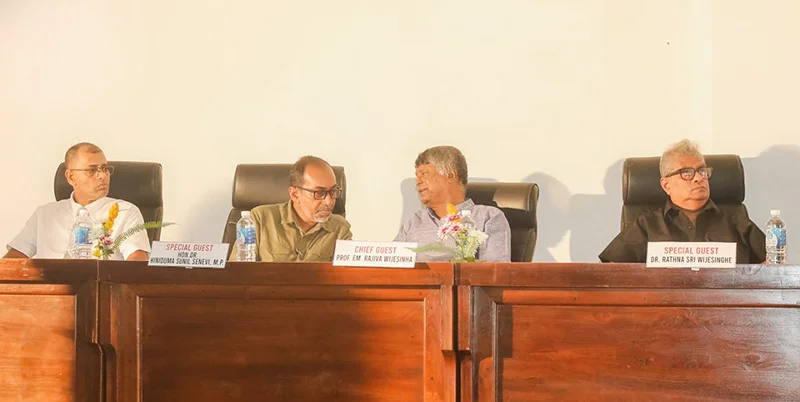
It is said that no man steps into the same river twice, for it is not the same river, and he is not the same man. These words came to mind upon reading Chandana Ruwan Jayanetti’s latest poetry collection, Poems from Galle, which inevitably invites comparison with his earlier work, particularly his first volume of poetry and prose, Reflections in Loneliness: A Collection of Poems and Prose (2015).
In this new collection, Jayanetti is demonstrably not the same poet he was a decade ago. His horizons have widened. his subject matter has diversified, and his thematic range has deepened. The earlier hallmarks of his work, including his empathetic attention to human experience, sensitivity to the natural world, and intimate, reflective tone, remain present. Yet they are now complemented by a stronger defiance, a more deliberate engagement with the political and the cosmic, and a broader mosaic of local and universal concerns. His poetic voice has evolved in scope, tonal range, and thematic ambition.
My own acquaintance with Jayanetti’s poetry dates back to our undergraduate days at Sabaragamuwa University of Sri Lanka, where we were classmates pursuing a BA in Languages (English Special). Even then, his work revealed precise observational skill coupled with profound sympathy for individuals. This early sensibility found fuller articulation in Reflections in Loneliness, a collection spanning nearly two decades of creative endeavor.
That inaugural volume traversed a wide thematic landscape: childhood memories; tender compassion toward humans and animals; tributes to the deserving; the joys and sorrows of young love; and reflections on Sri Lanka’s three-decade Northeast conflict, which concluded in 2009. Jayanetti’s verse, written with sincerity and empathy, moves fluidly from deeply personal to universally human. Moments of striking poignancy include the loss of his wife’s mother, the death of a young friend who marched unflinchingly to the warfront, and the bittersweet parting from a lover.
The prose section of Reflections in Loneliness offered a return to the rural simplicity of the 1970s and ’80s through the perspective of a schoolboy. Essays such as We Buy a Bicycle, Television Descends, The Village Goes to the Fair, Bathing Excursions and Hingurakanda evoke a bygone era with unvarnished authenticity. As literary critic Kamala Wijeratne noted, Jayanetti’s prose merited commendation for its perceptive and affectionate portrayal of rural life, written with the authority of lived experience. His meticulous attention to minute details revealed not only the flaws and frailties of human nature but also its loyalties and quiet virtues, articulated with unforced sympathy.
Consisting of 31 poems and five prose pieces, Reflections in Loneliness established Jayanetti as a writer of elegance, precision, and emotional depth. The current collection, however, confirms the Heraclitean and Buddhist insights: both the poet and his poetry have changed. The new work reflects an expansion from the personal to the cosmic, from the intimately local to the globally resonant, a testament to an artist in motion, carried forward by the ever-changing current of his creative life.
Jayanetti’s poetic corpus in the new book Poems from Galle, spanning thirty-five evocative works from They Heard the Cock Crow to A Birthday Celebration, reveals a profound and consistent artistic signature rooted in themes of humanity, nature, history, and social consciousness. Throughout these poems, Jayanetti demonstrates a distinctive voice that is simultaneously empathetic, contemplative, and alert to the complexities of his Sri Lankan heritage and the broader human condition. While maintaining a core of thematic and tonal consistency, each poem enriches this foundation by expanding into new dimensions of experience, whether personal, ecological, political, or historical.
A foundational element of Jayanetti’s poetry is the intimate relationship between humans and nature, frequently underscored by a deep ethical awareness. In poems like From a Herdman’s Life and My Neighbor, he gives voice to the quiet dignity of rural existence and animal companionship, portraying a symbiotic bond imbued with mutual care and respect. Similarly, Fallen Elephant and Inhumanity lament the cruelty inflicted upon majestic creatures, indicting human greed and violence. These poems articulate not only empathy for the natural world but also an implicit call for stewardship, threading a moral sensibility throughout the collection.
This concern extends to the socio-political sphere, as Jayanetti often situates his poems within the fraught realities of Sri Lanka’s history and struggles. Homage to Sir Henry Pedris honors a national martyr, while Confession of a Sri Lankan Cop exposes institutional corruption and personal integrity in tension. Hanuma Wannama and Gone Are They tackle political violence and social upheaval, reflecting the poet’s engagement with national trauma and collective memory. These works enrich the thematic landscape by connecting personal narrative to larger historical forces.

Jayanetti’s choice of subjects is remarkably diverse yet unified by a focus on lived experience—ranging from the intimate (To a Puppy That Departed, Benji) to the grand (Mekong, A Voyage). The poet’s attention to place, whether the Sri Lankan cityscape in City Morning and Evening from the College Terrace or the historic Ode to Galle Fort, anchors his work in locality while evoking universal themes of time, change, and belonging. Even poems centered on seemingly mundane moments, such as Staff Meeting or A Game, are elevated by the poet’s keen observational eye and capacity to find meaning in everyday rituals.
Moreover, Jayanetti often draws from historical and cultural memory, as seen in Ludowyk Remembered, Let Ho Chi Minh Guide You, and Rathna Sri Remembered, positioning his poetry as a dialogue between past and present. This choice expands his thematic range to include legacy, identity, and the power of remembrance, linking the individual to the collective consciousness.
Across the collection, Jayanetti’s tone is marked by a blend of gentle empathy and quiet strength. Poems such as A Companion Departed and To a Puppy That Departed convey tenderness and mourning with understated poignancy. His voice is intimate and accessible, inviting readers into personal reflections suffused with emotional depth.
Yet, this empathy is balanced by moments of stark realism and defiance.
In Corona and Hanuma Wannama, the tone shifts to urgent and accusatory, critiquing social injustice and political decay. A Ship Weeps mourns environmental devastation with an elegiac voice that is both sorrowful and admonitory. This tonal range reveals a poet capable of both consolation and confrontation, who embraces complexity rather than sentimentality.
While many poems explore specific moments or relationships, others invite contemplation on broader existential and cosmic themes. For instance, A Voyage and Mekong traverse spatial and temporal boundaries, evoking the interplay between human journeys and natural cycles. A Birthday Celebration reflects on legacy, learning, and the continuum of knowledge, blending personal homage with universal insight.
Even poems like A Bond and A Game gesture toward symbolic resonance, the former exploring interspecies loyalty as a metaphor for fidelity and duty, the latter invoking sport as a microcosm of life’s challenges and hopes. These works demonstrate Jayanetti’s ability to expand familiar motifs into metaphoric and philosophical territory, enriching his poetic landscape.
Jayanetti’s thirty-five poems in Poems from Galle collectively reveal a consistent and compelling artistic signature that intertwines compassionate engagement with nature and society, a profound sense of place, and an acute awareness of history and memory. His voice navigates seamlessly between moments of intimate reflection and urgent social commentary, creating a poetic landscape that resonates with both specificity and universality.
Each poem adds a distinct dimension to this mosaic. Historical and political awareness emerges strongly in poems like Let Ho Chi Minh Guide You and Homage to Sir Henry Pedris, where the sacrifices of national heroes and struggles for justice are evoked with reverence and clarity. Meanwhile, environmental consciousness is vividly articulated in works such as Abandoned Chena, Kottawa Forest, and Fallen Elephant, where the fragility of ecosystems and the human impact on nature are poignantly explored.
Jayanetti also delves deeply into themes of personal loss and companionship in poems like Benji, A Companion Departed, and In Memory of Brownie, tenderly capturing the bond between humans and animals. Poems like Confession of a Sri Lankan Cop and Hanuma Wannama offer raw social critique, revealing layers of political and moral complexity.
Through this interplay of historical, environmental, personal, and political themes, Jayanetti constructs a body of work that is distinctly Sri Lankan in its cultural and geographical grounding yet profoundly universal in its exploration of human experience. His poetry invites readers to reflect on the interconnected fates of humans, animals, and the natural world, urging a deeper awareness of our shared existence and responsibilities.
by Saman Indrajith
-

 Sports4 days ago
Sports4 days agoGurusinha’s Boxing Day hundred celebrated in Melbourne
-
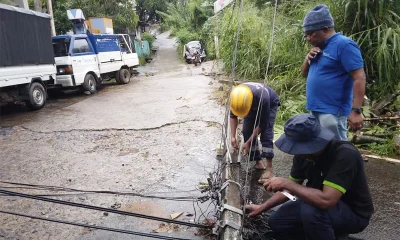
 News2 days ago
News2 days agoLeading the Nation’s Connectivity Recovery Amid Unprecedented Challenges
-

 Sports5 days ago
Sports5 days agoTime to close the Dickwella chapter
-

 Features3 days ago
Features3 days agoIt’s all over for Maxi Rozairo
-

 News5 days ago
News5 days agoEnvironmentalists warn Sri Lanka’s ecological safeguards are failing
-

 News3 days ago
News3 days agoDr. Bellana: “I was removed as NHSL Deputy Director for exposing Rs. 900 mn fraud”
-

 News2 days ago
News2 days agoDons on warpath over alleged undue interference in university governance
-

 Features5 days ago
Features5 days agoDigambaram draws a broad brush canvas of SL’s existing political situation


